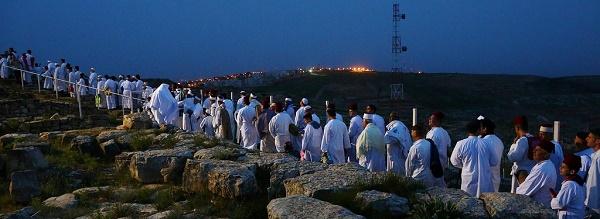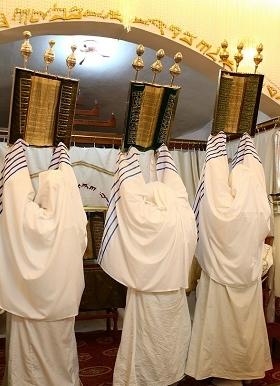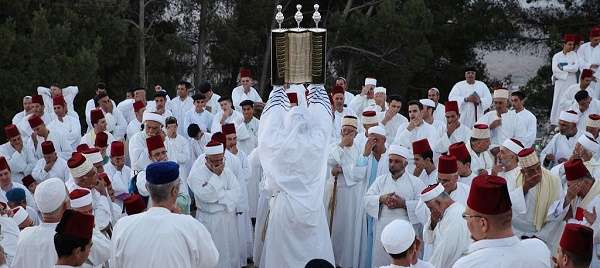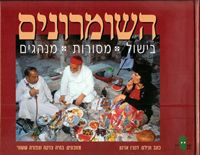 Edit article
Edit articleSeries
The Samaritan Shavuot: A Seven-Day Celebration of the Feast of Weeks

Note: All pictures of the Shavuot celebration were taken by non-Samaritans since Samaritans do not use any form of electricity on Yom Tov. Photo credits Ori Orhof, Modi’in, Israel. 2012
The Date of Samaritan Shavuot[1]
The Torah teaches that the holiday of Shavuot (Assaba’ot in Israelite-Samaritan[2] parlanc
Moreover, since the Torah discusses the waving of the omer immediately after the description of the Festival of Matzot, this must mean that the omer is waved on the first Sunday after Matzot, with Shavuot taking place 50 days, or seven Sundays, later. Thus, the Israelite-Samaritan community always celebrates Shavuot on the eighth Sunday after the Matzot festival ends, with the exact date varying slightly depending on what day of the week Matzot falls on in any given year.
Seven Days of Shavuot
The Samaritan sages, of blessed memory, determined that Shavuot should be seen as equal in status to the other pilgrimage holidays. Thus, they resolved that the festival of Shavuot, marking the climax of the fifty days of counting the omer, should also last for seven days, making the length of this holiday comparable to that of the festivals of Matzot and Sukkot. This elongation of the festival reflects its etymological connection to shavua, a week, and it is preceded by six special weeks.
This decision to extend the festival is in some ways comparable to the decision of the rabbinic sages to add an extra day of Yom Tov to every biblical festival. In both cases, the Jewish and Samaritan sages ended up adding six festival days to the calendar. For the Samaritans, the seven day festival of Shavuot begins on the Monday of the last week of the omer, and ends with biblical Shavuot on the following Sunday.[3] During the first five days of the festival week, work (melacha) is permitted.
The Themes of the Weeks Leading up to Shavuot
The seven weeks leading up to Shavuot each have a specific biblical theme in Samaritan tradition:
- Week of the crossing of the (Red) Sea (Exod. 14:26-15:21)
- Week of the changing of the water of marah (Exod. 15:22-26)
- Week of elim, where the Israelites found twelve water springs and seventy palm trees (Exod. 15:27-16:3)
- Week of the manna, which fell down upon them from heavens in the desert (Exod. 16:4-36)
- Week of the of water welling out from the rock (Exod. 17:1-7)
- Week of the battles against Amalek (Exod. 17:8-17)
- Week of the Decalogue (Exod. 19:1 ff.)
Thus, the week of Shavuot overlaps with the week of the Decalogue (beginning on the second day of that week). Thus, like the rabbinic community, the Samaritans connect Shavuot to the giving of the Torah.
The Laws and Customs of the Seven-Day Festival
For the Samaritans, the holy site upon which God chose to rest God’s name is not the Temple Mount in Jerusalem, but Mount Gerizim-Bet El.[4] This, in Samaritan belief, was the site of the binding of Isaac[5] and the site of the Tabernacle[6]; it is the site of the future Garden of Eden and the future Temple.[7]

Day 1 – The Day of Assembly (יום קהלה)
The opening day of the festival is called the Day of Assembly, to mark the day when the Samaritans gather for the second pilgrimage of the year (the first being Matzot and the third Sukkot). The day is devoted to visiting, with song and prayers, the sites that mark the parameters of the future Garden of Eden.
The area is demarcated by the following four places:
a) The Everlasting Hill (גבעת עולם) on Mt. Gerizim.
b) The Parcel of Land in Shechem, which according to Samaritan tradition, Jacob the forefather bought.
c) Joseph’s Tomb in Shechem (according to Samaritan tradition).
d) Kiryat Eburta [currently known as Awwarteh], the burial place according to Samaritan tradition of the High Priests, Elazar and Itamar, the sons of Aaron the High Priest, Pinchas ben Elazar and his son Abisha. This was also the burial place, according to Samaritan tradition, of the seventy elders and Samaritan High Priests.
Day 2 – The Night of Reading the Torah (ליל מקרתה)
On Tuesday, the second day of the festival week, the people are sanctified in preparation for the Day of the Revelation at Mount Sinai. In the evening, people gather in the synagogues for a special prayer service. Before every prayer, Samaritans wash their hands, face, nose, ears and feet with water, as Moses and Aaron did (Exod. 40:31).
Day 3 – Memorial Day of Sinai Assembly (יום מעמד הר סיני)
On the third day of the seven festival days, from midnight[8] to the following evening, the entire Torah is read and a variety of hymns are sung. The prayers are devoted to the remembrance of the Revelation at Mount Sinai. In Samaritan tradition, this day marks the day when Moses received the Decalogue from God at Sinai.
Days 4 and 5
Samaritans who live in Neveh Marqeh, a neighborhood in Holon, move to their second homes at Kiryat Luza on Mt. Gerizim to prepare for the pilgrimage. (Today, most Samaritans who do not live in Kiryat Luza have a second home there.)
Day 6 – Shabbat of the Decalogue (שבת עשרת הדברים)
 On the sixth day, the Sabbath, the prayers are devoted to a description of the giving of the Torah, which is why it is called the Sabbath of the Commandments. In the middle of the prayers, a hymn, composed in the 14th century and describing the giving of the Torah at Mt. Sinai, is sung.
On the sixth day, the Sabbath, the prayers are devoted to a description of the giving of the Torah, which is why it is called the Sabbath of the Commandments. In the middle of the prayers, a hymn, composed in the 14th century and describing the giving of the Torah at Mt. Sinai, is sung.
It is the custom for Samaritans to share the story of the giving of the Ten Commandments with their families.
The tenth commandment in the Samaritan version of the Torah differs from the Masoretic text or the Septuagint, and reads:
והיה כי יביאך י־הוה אלהיך אל ארץ הכנעני אשר אתה בא שמה לרשתה והקמת לך אבנים גדלות ושדת אתם בשיד וכתבת על האבנים את כל דברי התורה הזאת. והיה בעברכם את הירדן תקימו את האבנים האלה אשר אנכי מצוה אתכם היום בהר גריזים ובנית שם מזבח לי־הוה אלהיך מזבח אבנים. לא תניף עליהם ברזל, אבנים שלמות תבנה את מזבח י־הוה אלהיך. והעלית עליו עלות לי־הוה אלהיך וזבחת שלמים ואכלת שם ושמחת לפני י־הוה אלהיך, ההר ההוא בעבר הירדן אחרי דרך מבוא השמש בארץ הכנעני הישב בערבה מול הגלגל אצל אלון מוראמול שכם.
When Shehmaa[9] your Eloowwem[10] will bring you to the land of the Canaanite, which you are going to inherit it, you shall set yourself up great stones, and lime them with lime, and you shall write on them all the words of this law. It shall be, when you are passed over the Yaardan [Jordan River], you shall set up these stones, which I command you today, in Aargaareezem [Mount Gerizim]. There shall you build an altar to Shehmaa your Eloowwem, an altar of stones: you shall lift up no iron tool on them. You shall build the altar of Shehmaa your Eloowwem of uncut stones; and you shall offer burnt offerings thereon to Shehmaa your Eloowwem: and you shall sacrifice offerings, and shall eat there; and you shall rejoice before Shehmaa your Eloowwem. [Upon] that mountain, in the other side of the Yaardaan, behind the way of the sunset, in the land of the Canaanite who dwell in the Aaraabaah, before the Galgaal, beside the plain of Moorah, before Ashkem [Shechem].[11]
Day 7 – The Festival of Weeks, The Harvest Festival
Sunday is the festival of Shavuot. The day begins with a cold meal, mostly salads and cheeses (since Samaritans do not cook on Shabbat, and Shavuot always falls out after Shabbat.) The prayers begin after midnight in the synagogue at Kiryat Luza on Mount Gerizim. The all night service is similar to the Jewish custom to learn Torah all night on Shavuot, Tikkun Leil Shavuot. At about 4:00 a.m. the congregation leaves the synagogue and makes the pilgrimage to the mountaintop. On the way up, the Song of the Sea will be sung. while singing and praying. They move from station to station:
- The first station is the Place of the Stones [The Twelve Stones, Deut. 27:4; in the Samaritan version of the Torah: Mount Gerizim].
- The second stop is the site of the altar of Adam and his son Seth.
- The next is the site of God Will Provide [God Will Provide, Gen. 22:8], where Abraham saw a ram in the thicket when he was about to sacrifice his son, Isaac.
- The following stop is the site of the Altar of Isaac.
- The next station is the Altar of Noah.
- The next stop is the site of the Everlasting Hill. [The Everlasting Hill, Deut. 33:15]. (Note: In the past, two monuments of Jacob marked the place and this had been the third station. It is now the last station.)
At each one of these six stations, the Kohen Gadol (high priest) will wave the Sefer Torah. The prayers are devoted to the Harvest Festival, the main theme of the festival in both the Masoretic and Samaritan Bibles, neither of which connect Shavuot explicitly too the giving of the Torah.

The Shavuot Festive Meal
Samaritans eat several traditional foods Samaritans on Shavuot, including the Sarah and Hagar dish, a half white (Sarah) and half red (Hagar) custard dish. There are also labneh cheese balls (made from yogurt), salt cookies called meqamar, and a roasted wheat soup called freekah (the word means “newly plucked wheat”). Passages from the Torah including the Decalogue are combined with hymns in prayer during this meal.
 Other traditional foods are grape leaves stuffed with rice and meat, and zucchini stuffed with chicken breast and spices. These are not eaten at the same meal with the dairy foods, as Samaritans do not mix milk and meat (including poultry) and even wait 3 hours after the consumption of dairy before eating meat (6 hours for dairy after meat).
Other traditional foods are grape leaves stuffed with rice and meat, and zucchini stuffed with chicken breast and spices. These are not eaten at the same meal with the dairy foods, as Samaritans do not mix milk and meat (including poultry) and even wait 3 hours after the consumption of dairy before eating meat (6 hours for dairy after meat).
After the meal and our all night prayers, we sleep. Thus ends the festival of Shavuot and a weeks’ worth of prayer and Torah study; a fitting way to celebrate the second pilgrimage of the year and God’s revelation to Israel at Sinai 3692 years ago (Samaritan counting).
TheTorah.com is a 501(c)(3) nonprofit organization.
We rely on the support of readers like you. Please support us.
Published
May 27, 2014
|
Last Updated
December 20, 2025
Previous in the Series
Next in the Series
Before you continue...
Thank you to all our readers who offered their year-end support.
Please help TheTorah.com get off to a strong start in 2025.
Footnotes

Benyamim Tsedaka is the founder and head of the A.B-Institute of Samaritan Studies. He is the editor of A.B. – The Samaritan News Magazine, A Founder of the Society of Samaritan Studies in Paris 1985, the conductor of the Choir of Ancient Israelite Music, and the chairperson of the Samaritan Medal Foundation. Tsedaka has published over 100 articles, essays, and posts on Samaritan Studies. He recently published the firstEnglish translation of the Samaritan Pentateuch.
Essays on Related Topics:









